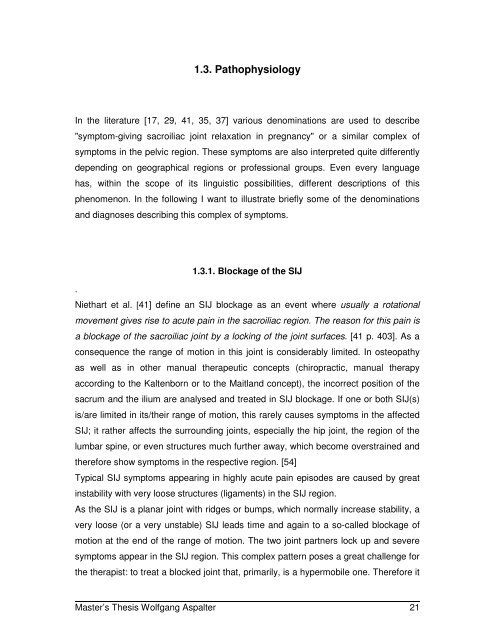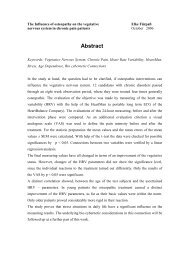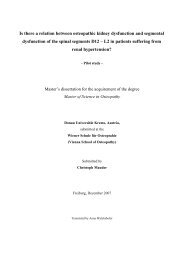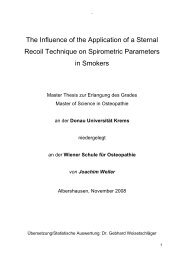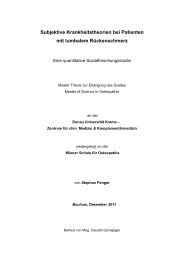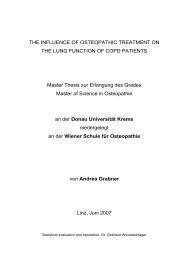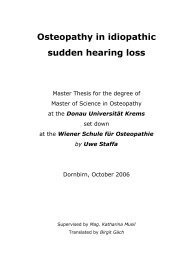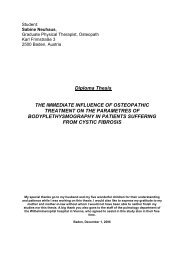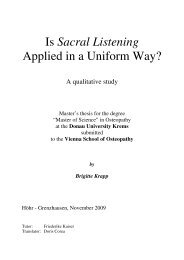Can back pain caused by symptom-giving sacroiliac joint relaxation ...
Can back pain caused by symptom-giving sacroiliac joint relaxation ...
Can back pain caused by symptom-giving sacroiliac joint relaxation ...
Create successful ePaper yourself
Turn your PDF publications into a flip-book with our unique Google optimized e-Paper software.
1.3. Pathophysiology<br />
In the literature [17, 29, 41, 35, 37] various denominations are used to describe<br />
"<strong>symptom</strong>-<strong>giving</strong> <strong>sacroiliac</strong> <strong>joint</strong> <strong>relaxation</strong> in pregnancy" or a similar complex of<br />
<strong>symptom</strong>s in the pelvic region. These <strong>symptom</strong>s are also interpreted quite differently<br />
depending on geographical regions or professional groups. Even every language<br />
has, within the scope of its linguistic possibilities, different descriptions of this<br />
phenomenon. In the following I want to illustrate briefly some of the denominations<br />
and diagnoses describing this complex of <strong>symptom</strong>s.<br />
1.3.1. Blockage of the SIJ<br />
.<br />
Niethart et al. [41] define an SIJ blockage as an event where usually a rotational<br />
movement gives rise to acute <strong>pain</strong> in the <strong>sacroiliac</strong> region. The reason for this <strong>pain</strong> is<br />
a blockage of the <strong>sacroiliac</strong> <strong>joint</strong> <strong>by</strong> a locking of the <strong>joint</strong> surfaces. [41 p. 403]. As a<br />
consequence the range of motion in this <strong>joint</strong> is considerably limited. In osteopathy<br />
as well as in other manual therapeutic concepts (chiropractic, manual therapy<br />
according to the Kaltenborn or to the Maitland concept), the incorrect position of the<br />
sacrum and the ilium are analysed and treated in SIJ blockage. If one or both SIJ(s)<br />
is/are limited in its/their range of motion, this rarely causes <strong>symptom</strong>s in the affected<br />
SIJ; it rather affects the surrounding <strong>joint</strong>s, especially the hip <strong>joint</strong>, the region of the<br />
lumbar spine, or even structures much further away, which become overstrained and<br />
therefore show <strong>symptom</strong>s in the respective region. [54]<br />
Typical SIJ <strong>symptom</strong>s appearing in highly acute <strong>pain</strong> episodes are <strong>caused</strong> <strong>by</strong> great<br />
instability with very loose structures (ligaments) in the SIJ region.<br />
As the SIJ is a planar <strong>joint</strong> with ridges or bumps, which normally increase stability, a<br />
very loose (or a very unstable) SIJ leads time and again to a so-called blockage of<br />
motion at the end of the range of motion. The two <strong>joint</strong> partners lock up and severe<br />
<strong>symptom</strong>s appear in the SIJ region. This complex pattern poses a great challenge for<br />
the therapist: to treat a blocked <strong>joint</strong> that, primarily, is a hypermobile one. Therefore it<br />
Master’s Thesis Wolfgang Aspalter 21


